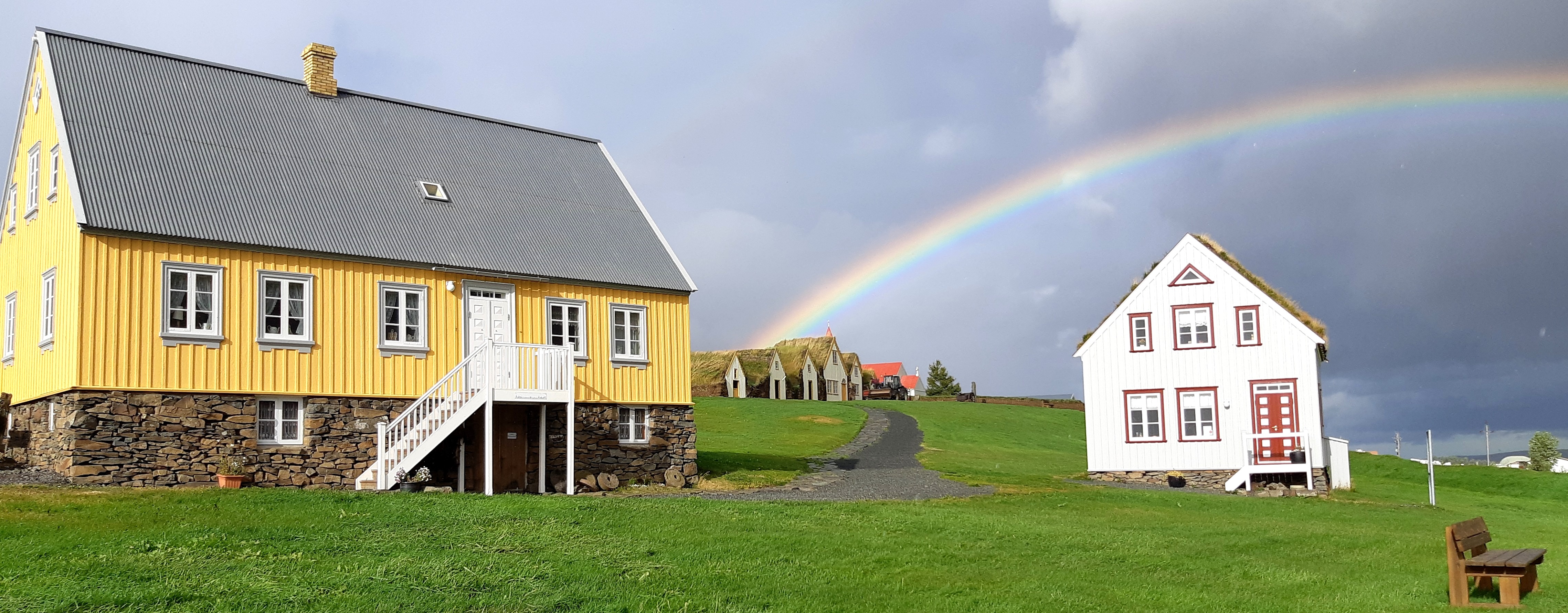 At Glaumbær, there are two 19th-century timber houses, Áshús and Gilsstofa. These are good examples of the first timber houses built in the region. The yellow building is Áshús, while the gray one is Gilsstofa. Áshús contains exhibitions and the museums tea room/café, which serves traditional Icelandic delicacies.
At Glaumbær, there are two 19th-century timber houses, Áshús and Gilsstofa. These are good examples of the first timber houses built in the region. The yellow building is Áshús, while the gray one is Gilsstofa. Áshús contains exhibitions and the museums tea room/café, which serves traditional Icelandic delicacies.
Áshús was built at Ás at Hegranes, Skagafjörður in 1884-86. It was moved to the Glaumbær Museum site in 1991. The house, in its new location near to the old turf farmhouse, represents the type of buildings that supplanted turf houses in the 19th century. The house also serves as a reminder of the hard lives lived by Icelandic rural people, and tells the story of an influential home that played an important role in improving agricultural methods and techniques in the region in the period around 1900. Many technical innovations which had not been seen before in Skagafjörður were first demonstrated at Ás. Some of them were imported, others adapted or invented. The family at Ás also introduced many other improvements, and there is no doubt that they led to considerable progress in agricultural skills in Skagafjörður in the period 1870-1920.

Sigurlaug Gunnarsdóttir, the houswife at Ás, was a skilled craftswoman who made the first Icelandic ceremonial costume of modern design. She founded the first women's association in Iceland in 1869, and was the director of one of the first girls schools in Iceland, which was established in 1877. The house was constructed with the idea of opening a girls school, but this never came to pass. By 1977, when the last resident moved out of the house, four generations had lived in it. The couple who built the house were progressive people who campaigned for individual rights and promoted education of all kinds. They held courses at their home for both boys and girls for several decades and had a great influence on improvement and progress in the agriculture of the region at their time.
Gilsstofa is based on this house (on the right) from 1849. Buildings of this kind were constructed in many places adjacent to turf farmhouses, they were the precursors to the wooden houses that were built in the years leading up to 1900. Gilsstofa has an interesting history as it was repeatedly moved from place to place in the years from 1862 to 1891.

The house was built at Espihóll in Eyjafjörður as a reception room and residence. In 1862 its owner became district administrator of Skagafjörður, so he took the house with him. In those days, timber for construction was transported over ice, pulled by horses. The first leg of the journey was over the ice from Espihóll to Akureyri, where the timber was loaded onto a ship which transported it to Skagafjörður. From there the timber was then towed to Hjaltastaðir, where the regional administrator lived until 1872. The house was dismantled once more, and the timber was dragged over the frozen waters of Héraðsvötn to Reynistaður, where it remained until 1884. From 1873 to 1892, the building housed the Skagafjörður regional administration, and was also used as a location for social gatherings. It served as a theatre for the first local drama productions, and a variety of entertainments were held there.
In 1884, a new regional administrator took over. He lived at Gil, not far from Reynistaður, the house was moved there, where it remained until 1891, when it was transferred to Sauðárkrókur. In its sixth incarnation, it was assigned a new function. It was now known as Gilsstofa (the house from Gil). In 1985 it was taken on yet another journey by road to a farm, finishing up almost where it began its tour of Skagafjörður in the mid-19th century. Gilsstofa was reconstructed at the Glaumbær museum in 1996-97.
